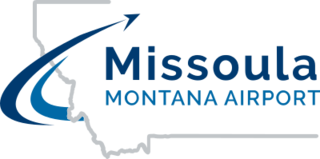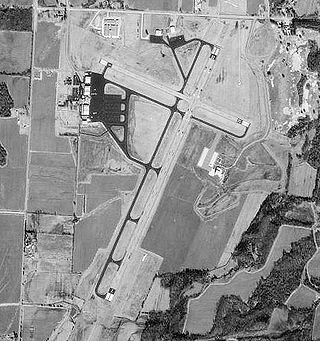
Cleveland Hopkins International Airport is a city-owned international airport in Cleveland, Ohio, United States, and is the primary airport serving Greater Cleveland and Northeast Ohio. It the largest and busiest airport in the state, as well as the 43rd-busiest airport in the U.S. by passenger numbers. Located in Cleveland's Hopkins neighborhood 9 miles (14 km) southwest of Downtown Cleveland, it is adjacent to the Glenn Research Center, one of NASA's ten major field centers.

Pensacola International Airport, formerly Pensacola Gulf Coast Regional Airport and Pensacola Regional Airport, and temporarily branded Pensacola Intergalactic Airport each February in recognition of the local Pensacon convention, is a public use airport three nautical miles northeast of the central business district of Pensacola, in Escambia County, Florida, United States. It is owned by the City of Pensacola. Despite its name, the airport does not offer scheduled international flights, though chartered international flights are not uncommon. This airport is one of the five major airports in North Florida, and among these is the second largest by passenger count, only behind Jacksonville. The other airports in the North Florida region are: Northwest Florida Beaches International Airport, Destin-Fort Walton Beach Airport, Tallahassee International Airport, and Jacksonville International Airport.

Greater Hartford is a region located in the U.S. state of Connecticut, centered on the state's capital of Hartford. It represents the only combined statistical area in Connecticut defined by a city within the state, being bordered by the Greater Boston region to the northeast and New York metropolitan area to the south and west. Sitting at the southern end of the Metacomet Ridge, its geology is characterized by land of a level grade along the shores of Connecticut River Valley, with loamy, finer-grained soil than other regions in the state. Greater Hartford, had a total population of 1,213,531 at the 2020 United States census.

McNary Field is in Marion County, Oregon, United States, two miles southeast of downtown Salem, which owns it. The airport is named for U.S. Senator Charles L. McNary.

Rogue Valley International–Medford Airport is a public-use airport three miles north of downtown Medford, in Jackson County, Oregon, United States. Owned and operated by Jackson County's Aviation Authority, the airport serves southwest Oregon. Originally named Medford–Jackson County Airport, it was renamed to Rogue Valley International–Medford Airport after it became an international airport in 1994.
Chadron Municipal Airport is in Dawes County, Nebraska, United States, five miles west of Chadron. It sees one airline, Southern Airways Express, subsidized by the Essential Air Service program.

Cavern City Air Terminal is a public use airport in Eddy County, New Mexico, United States. It is owned by the city of Carlsbad and located five nautical miles southwest of its central business district. The airport is served by one commercial airline, with scheduled passenger service subsidized by the Essential Air Service program.
Grant County Airport is a county-owned, public-use airport in Grant County, New Mexico, United States. It is located 10 nautical miles southeast of the central business district of Silver City, New Mexico. The airport is mostly used for general aviation, but is also served by one commercial airline. Service is subsidized by the Essential Air Service program.
Clovis Regional Airport is a city-owned, public-use airport located six nautical miles east of the central business district of Clovis, a city in Curry County, New Mexico, United States. The facility opened in April, 1959 and is mostly used for general aviation, but is also served by one commercial airline. Current scheduled passenger service is subsidized by the Essential Air Service program. The airport was previously known as Clovis Municipal Airport but underwent a name change to Clovis Regional Airport in 2021 when it was upgraded to Part 121 status.

Monroe Regional Airport is a public use airport in Ouachita Parish, Louisiana, United States. The airport is owned by the City of Monroe and is located within the city limits three nautical miles (6 km) east of its central business district.

Bozeman Yellowstone International Airport is located in Belgrade, Montana, United States, eight miles northwest of Bozeman. Owned by the Gallatin Airport Authority, it has been Montana's busiest airport since 2013.

Bradford Regional Airport is 11 miles south of Bradford, in Lafayette Township, McKean County, Pennsylvania. It has scheduled airline service subsidized by the Essential Air Service program.

Fayetteville Regional Airport, also known as Grannis Field, is a public use airport in Cumberland County, North Carolina, United States. It is owned by the city of Fayetteville and located three nautical miles (6 km) south of its central business district.

Missoula Montana Airport is located in Missoula, in Missoula County, Montana. It is owned by the Missoula County Airport Authority.
L. M. Clayton Airport is a public airport three miles east of Wolf Point, in Roosevelt County, Montana, United States. The airport is served by one airline, subsidized by the Essential Air Service program. Reportedly, it is the smallest airport in the 48 contiguous states with scheduled air service.

McKellar–Sipes Regional Airport is a public use airport located four nautical miles (7 km) west of the central business district of Jackson, a city in Madison County, Tennessee, United States. It is owned by the city and county. The airport is mostly used for general aviation, and is served by one commercial airline, Southern Airways Express, subsidized by the Essential Air Service program.

Massena International Airport is in St. Lawrence County, New York. It is two nautical miles (3.7 km) east of the village of Massena. The airport sees one airline, subsidized by the Essential Air Service program.

Killeen Regional Airport is a small military/commercial joint-use airport that operates alongside Robert Gray Army Airfield. The airport is based inside the south end of the Fort Cavazos Military Reservation, six nautical miles southwest of the central business district of Killeen, Texas, in unincorporated Bell County. The commercial side replaced the old Killeen Municipal Airport in August, 2004 as that airport was unable to expand. Formerly Killeen–Fort Hood Regional Airport, on 26 September, 2023, the airport began the multi-month process of renaming to "Killeen Regional Airport", as approved by the Killeen City Council.

Hartford–Brainard Airport is a towered public airport three miles (5 km) southeast of downtown Hartford, in Hartford County, Connecticut, United States. It is owned by the Connecticut Airport Authority. The Federal Aviation Administration (FAA) National Plan of Integrated Airport Systems for 2017–2021 categorized it as a regional reliever airport facility.

General Wayne A. Downing Peoria International Airport is a civil/military public airport five miles west of Peoria, in Peoria County, Illinois, United States. It is on the northwest edge of Bartonville, near Bellevue. It is owned by the Metropolitan Airport Authority of Peoria, which often refers to it as Peoria International Airport. It was formerly the Greater Peoria Regional Airport.





















